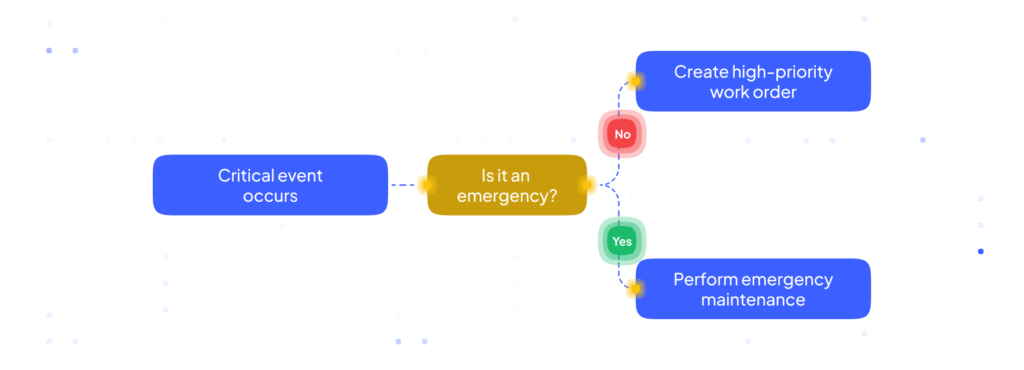Emergency maintenance refers to urgent and critical repairs required to address immediate issues that pose a threat to the safety, functionality, or security of a property. In this article, we will explore the nature of emergency maintenance, its differentiation from other maintenance approaches, and the importance of proactive measures to prevent emergencies from occurring.
What Is Emergency Maintenance?
Emergency maintenance involves responding swiftly to unforeseen situations that require immediate attention to prevent further damage or disruptions. It aims to resolve urgent issues that pose risks to occupants, property integrity, or the smooth operation of essential systems. Prompt response and effective resolution are crucial in emergency maintenance to mitigate potential hazards and minimise downtime.

Examples of Emergency Maintenance
Common emergency maintenance scenarios include plumbing failures, electrical issues, HVAC malfunctions, roof leaks, and security breaches. Urgent emergencies, such as gas leaks or severe water damage, require immediate attention, while non-urgent emergencies, such as minor electrical disruptions, can be addressed within a reasonable timeframe.
Imagine a bustling commercial building with various businesses operating on multiple floors. Suddenly, a loud burst of water echoes through the hallway, causing panic among occupants. The source of the commotion is a burst water pipe in one of the restroom areas.
The water gushes out rapidly, flooding the corridor and posing an immediate threat to electrical systems, elevators, and other sensitive equipment. The situation becomes critical, endangering the safety of the building’s occupants and the integrity of the property.
In this scenario, the burst water pipe constitutes an emergency maintenance situation. The urgency lies in the need to swiftly halt the water flow, repair the broken pipe, and mitigate potential water damage. The property maintenance team must respond promptly to prevent further harm to the building’s structure, electrical systems, and valuable assets.
Difference between Emergency Maintenance and Reactive Maintenance

Reactive maintenance involves addressing issues after they occur, primarily focusing on restoring functionality rather than preventing problems. Emergency maintenance, on the other hand, is a subset of reactive maintenance that deals specifically with urgent situations. The key difference lies in the time sensitivity and critical nature of emergency maintenance compared to reactive maintenance.
Difference between Emergency Maintenance and Preventive Maintenance
Preventive maintenance aims to proactively identify and address potential issues before they escalate into emergencies. It involves scheduled inspections, routine maintenance tasks, and adherence to maintenance plans. Whilst emergency maintenance is reactive and addresses immediate concerns, preventive maintenance focuses on preventing emergencies by taking preventive actions and maintaining assets regularly.
How to avoid Emergency Maintenance
Preventing emergencies requires a proactive approach, and implementing preventive maintenance strategies is, therefore, essential. This includes developing preventive maintenance schedules, conducting regular inspections, and performing necessary repairs and replacements in a timely manner.
On the other hand, root cause analysis helps identify recurring issues and address underlying problems effectively. In the forementioned example of the burst water pipe, after isolating and replacing the damaged section of the pipe, the maintenance team should perform thorough checks on other plumbing lines to prevent similar incidents in the future.
An Intelligent Maintenance Management Platform (IMMP), can significantly reduce the occurrence of emergency maintenance situations by focusing on proactive preventive measures and streamlining maintenance operations. Here’s how an IMMP can help avoid emergency maintenance:
Preventive Maintenance Scheduling
An IMMP allows property managers to create and schedule preventive maintenance tasks in advance. Regular inspections, routine maintenance, and timely repairs are planned systematically, helping to identify and address potential issues before they escalate into emergencies.
Real-time Monitoring and Alerts
An IMMP provides real-time monitoring of equipment and assets. The platform can detect anomalies or deviations from normal operating conditions and send automatic alerts to maintenance teams. Early detection of issues allows for immediate action to prevent further damage or potential emergencies.
Condition-based Monitoring
This kind of platform offers condition-based monitoring capabilities, enabling proactive maintenance. By integrating sensors and data from equipment, an IMMP can analyse performance trends and identify signs of potential failure. This allows maintenance teams to intervene before a breakdown occurs, avoiding costly emergency repairs.
Root Cause Analysis
When incidents do occur, an IMMP facilitates root cause analysis to determine the underlying reasons behind failures. This way, maintenance teams can implement corrective actions to prevent similar emergencies in the future.
Efficient Work Order Management
An IMMP streamlines work order management, ensuring that maintenance tasks are promptly assigned and completed. Timely response to regular maintenance requests helps prevent minor issues from escalating into emergency situations.
Resource Planning and Allocation
The platform optimises resource planning and allocation, ensuring that the right personnel with the necessary skills and tools are available to address maintenance tasks.
Asset Lifecycle Management
IMMPs facilitate comprehensive asset lifecycle management. It tracks the performance and maintenance history of assets, allowing maintenance teams to prioritise critical equipment and plan for replacements or upgrades before they become liabilities.
Enhanced Communication and Collaboration
Last, an IMMP improves communication and collaboration between property managers, maintenance teams, and other stakeholders. Quick access to information and efficient communication channels enable faster response times and more effective coordination during critical situations.

